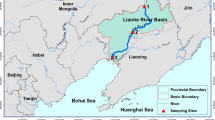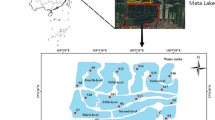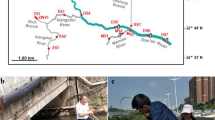Abstract
Sediment dredging can permanently remove pollutants from an aquatic ecosystem, which is considered an effective approach to aquatic ecosystem restoration. In this work, a 2-year field simulation test was carried out to investigate the effect of dredging on nitrogen cycling across the sediment-water interface (SWI) in Lake Taihu, China. The results showed that simulated dredging applied to an area rich in total organic carbon (TOC) and total nitrogen (TN) slightly reduced the NH4 +-N release from sediments while temporarily enhanced the NH4 +-N release in an area with lower TOC and/or TN (in the first 180 days), although the application had a limited effect on the fluxes of NO2 −-N and NO3 −-N in both areas. Further analysis indicated that dredging induced decreases in nitrification, denitrification, and anaerobic ammonium oxidation (anammox) in sediments, notably by 76.9, 49.0, and 89.9 %, respectively, in the TOC and/or TN-rich area. Therefore, dredging slowed down nitrogen cycling rates in sediments but did not increase N loading to overlying water. The main reason for the above phenomenon could be attributed to the removal of the surface sediments enriched with more TOC and/or TN (compared with the bottom sediments). Overall, to minimize internal N pollution, dredging may be more applicable to nutrient-rich sediments.







Similar content being viewed by others
References
Bastviken SK, Eriksson PG, Premrow A, Tonderski K (2005) Potential denitrification in wetland sediments with different plant species detritus. Ecol Eng 25:183–190
Bowman JC, Readman JW, Zhou JL (2003) Seasonal variability in the concentrations of Irgarol 1051 in Brighton Marina, UK; including the impact of dredging. Mar Pollut Bull 46:444–451
Bremle G, Larsson P (1998) PCB concentration in fish in a river system after remediation of contaminated sediment. Environ Sci Technol 32(22):3491–3495
Cavari BZ, Phelps G (1977) Denitrification in lake Kinneret in the presence of oxygen. Freshwater Biol 7:385–391
Chen HB, Wang DB, Li XM, Yang Q, Zeng GM (2015) Enhancement of post-anoxic denitrification for biological nutrient removal: effect of different carbon sources. Environ Sci Pollut Res 22:5887–5894
Christensen PB, Nielsen LP, SØrensen J, Revsbech NP (1990) Denitrification in nitrate-rich streams: diurnal and seasonal variation related to benthic oxygen metabolism. Limnol Oceanogr 35:640–651
Cornwell JC, Owens MS (2011) Quantifying sediment nitrogen releases associated with estuarine dredging. Aquat Geochem 17:499–517
D’Haene K, Moreels E, De Neve S, Daguilar BC, Boeckx P, Hofman G, Cleemput OV (2003) Soil properties influencing the denitrification potential of Flemish agricultural soils. Biol Fertile Soils 38:358–366
Dollhopf SL, Hyun JH, Smith AC, Adams HJ, O’Brien S, Kostka JE (2005) Quantification of ammonia-oxidizing bacteria and factors controlling nitrification in salt marsh sediments. Appl Environ Microb 71(1):240–246
Duan HT, Ma RH, Xu XF, Kong FX, Zhang SX, Kong WJ, Hao JY, Sheng LL (2009) Two-decade reconstruction of algal blooms in China’s Lake Taihu. Environ Sci Technol 43(10):3522–3528
Falcào M, Gaspar MB, Caetano M, Santos MN, Vale C (2003) Short-term environmental impact of clam dredging in coastal waters (south of Portugal): chemical disturbance and subsequent recovery of seabed. Mar Environ Res 56:649–664
Fan CX, Yang LY, Zhang L (2000) The vertical distributions of nitrogen and phosphorus in the sediment and interstitial water in Taihu Lake and their interrelations. J Lake Sci 12(4):359–366 (in China)
Fan CX, Zhang L, Wang JJ, Zheng CH, Gao G, Wang SM (2004) Processes and mechanism of effects of sludge dredging on internal source release in lakes. Chinese Sci Bull 49(17):1853–1859 (in China)
Graca B, Burska D, Matuszewska K (2004) The impact of dredging deep pits on organic matter decomposition in sediments. Water Air Soil Poll 158:237–259
Gustavson K, Allen Burton G, Francingues NJR, Reible DD, Vorhees DJ, Wolfe JR (2008) Evaluating the effectiveness of contaminated-sediment dredging: as the science of environmental dredging and sediment management changes, adaptive management strategies can help long-term remediation projects keep pace. Environmen Sci Technol 15:5042–5047
Hall GH (1984) Measurement of nitrification rates in lake sediments: comparison of the nitrification inhibitors nitrapyrin and allylthiourea. Microbial Ecol 10:25–36
Hanaki K, Wantawin C, Ohgaki S (1990) Nitrification at low levels of dissolve oxygen with and without organic loading in a suspended-growth reactor. Water Res 24(3):297–302
** XC, Tu QY (1990) The standard methods in lake eutrophication investigation, 2nd edn. China Environmental Science Press, Bei**g
** XC (2003) Analysis of eutrophication state and trend for lakes in China. J Limnol 62(2):60–66
**g LD, Wu CX, Liu JT, Wang HG, Ao HY (2013) The effects of dredging on nitrogen balance in sediment-water microcosms and implications to dredging projects. Ecol Eng 52:167–174
Joye SB, Anderson IC (2008) Nitrogen cycling in coastal sediments. In: Capone DG, Bronk DA, Mulholland MR, Carpenter EJ (eds) Nitrogen in the marine environment, 2nd edn. Academic, Amsterdam, pp 868–915
Kleeberg A, Kohl JG (1999) Assessment of the long-term effectiveness of sediment dredging to reduce benthic phosphorus release in shallow lake Müggelsee (Germany). Hydrobiologia 394:153–161
Lewis MA, Weber DE, Stanley RS, Moore JC (2001) Dredging impact on an urbanized Florida bayou: effects on benthos and algal-periphyton. Environ Pollut 115:161–171
Liu DD, Li ZK, Zhang WG (2014) Nitrate removal under different ecological remediation measures in Taihu Lake: a 15N mass-balance approach. Environ Sci Pollut Res 21:14138–14145
Liu TZ, Yuan JJ, Dong WY, Wu HC, Wang HJ (2015) Effects on inorganic nitrogen compounds release of contaminated sediment treatment with in situ calcium nitrate injection. Environ Sci Pollut Res 22:1250–1260
Lohrer AM, Wetz JJ (2003) Dredging-induced nutrient release from sediments to the water column in a southeastern salt marsh tidal creek. Mar Pollut Bull 46:1156–1163
Ma RH, Duan HT, Gu XH, Zhang SX (2008) Detecting aquatic vegetation changes in Taihu Lake, China using multi-temporal satellite imagery. Sensors 8(6):3988–4005
Maguire JA, Coleman A, Jenkins S, Burnell GM (2002) Effects of dredging on undersized scallops. Fish Res 56:155–165
Mogge B, Kaiser EA, Munch JC (1999) Nitrous oxide emissions and denitrification N-losses from agricultural soils in the Bornhoved lake region: influence of organic fertilizers and land-use. Soil Biol Biochem 31:1245–1252
Morin J, Morse JW (1999) Ammonium release from resuspended sediments in the Laguna Madre estuary. Mar Chem 65:97–110
Nielsen LP (1992) Denitrification in sediment determined from nitrogen isotope pairing. Fems Microbiol Ecol 86:357–362
Nishio T, Koike I, Hattori A (1982) Denitrification, nitrate reduction, and oxygen consumption in coastal and estuarine sediments. Appl Environ Microb 43(3):648–653
Pan G, Dai LC, Li L, He LC, Li H, Bi L, Gulati RD (2012) Reducing the recruitment of sedimented algae and nutrient release into the overlying water using modified soil/sand flocculation-cap** in Eutrophic lakes. Environ Sci Technol 46:5077–5084
Peter K, Zhu W, Mario M (2005) Water and mass budgets for estimating phosphorus sediment-water exchange in Lake Taihu (China P. R). Hydrobiologia 544:167–175
Pinay G, O’Keefe T, Edwards R, Naiman RJ (2003) Potential denitrification activity in the landscape of a western Alaska drainage basin. Ecosystems 6:336–343
Pu PM, Wang GX, Hu CH, Fan CX (2000) Can we control lake eutrophication by dredging? J Lake Sci 12(3):269–279 (in China)
Qin BQ, Yang LY, Chen FZ, Zhu GW, Zhang L, Chen YY (2006) Mechanism and control of lake eutrophication. Chinese Sci Bull 51(19):2401–2412 (in China)
Qin BQ, Zhu GW (2006) The nutrient forms, cycling and exchange flux in the sediment and overlying water system in lakes from the middle and lower reaches of Yangtze River. Sci China (SerD) 49(1):1–13
Qin BQ, Hu WP, Gao G, Luo LC, Zhang JS (2004) Dynamics of sediment resuspension and the conceptual schema of nutrient release in the large shallow Lake Taihu, China. Chinese Sci Bull 49:54–64 (in China)
Recknagel F, Hosomi M, Fukushima T, Kong DS (1996) Short- and long-term control of external and internal phosphorus loads in lakes—a scenario analysis. Water Res 29:1767–1779
Reddy KR, Fisher MM, Wang Y, White JR, Thomas James R (2007) Potential effects of sediment dredging on internal phosphorus loading in a shallow, subtropical lake. Lake Reserv Manage 23:27–38
Rysgaard S, Glud RN, Risgaard-Petersen N, Dalsgaard T (2004) Denitrification and anammox activity in Arctic marine sediment. Limnol Oceanogr 49(5):1493–1502
Seitzinger SP (1994) Linkages between organic matter mineralization and denitrification in eight riparian wetlands. Biogeochemistry 25:19–39
Smith VH, Tilman GD, Nekola JC (1999) Eutrophication: impacts of excess nutrient inputs on freshwater, marine, and terrestrial ecosystems. Environ Pollut 100:179–196
Spencer KL, Dewhurst RE, Penna P (2006) Potential impacts of water injection dredging on water quality and ecotoxicity in Limehouse Basin, River Thames, SE England, UK. Chemosphere 63:509–521
Svensson JM, Leonardson L (1996) Effects of bioturbation by tube-dwelling chironomid larvae on oxygen uptake and denitrification in eutrophic lake sediments. Freshwater Biol 35:289–300
Szymelfenig M, Kotwicki L, Graca B (2006) Benthic re-colonization in post-dredging pits in the Puck bay (southern Baltic sea). Estuar Coast Shelf S 68:489–498
Thamdrup B, Dalsgaard T (2002) Production of N2 through anaerobic ammonium oxidation coupled to nitrate reduction in marine sediments. Appl Environ Microb 68(3):1312–1318
Toet S, Huibers LHFA, Van Logtesijn RSP (2003) Denitrification in the periphyton associated with plant shoots and in the sediment of a wetland system supplied with sewage treatment plant effluent. Hydrobiologia 501:29–44
Trimmer M, Nicholls JC, Deflandre D (2003) Anaerobic ammonium oxidation measured in sediments along the Thames estuary, United Kingdom. Appl Environ Microb 69(11):6447–6454
Tuck ID, Bailey N, Harding M, Sangster G, Howell T, Graham N, Breen M (2000) The impact of water jet dredging for razor clams, Ensis spp., in a shallow sandy subtidal environment. Journal of Sea Research 43:65–81
Ullman WJ, Aller RC (1982) Diffusion coefficients in nearshore marine sediments. Limnol Oceanogr 27:552–556
Usui T, Koike I, Ogura N (2001) N2O production, nitrification and denitrification in an estuarine sediment. Estuar Coast Shelf S 52:769–781
Van den berg GA, Meijers GA, Van der heijdt LM, Zwolsman JJG (2001) Dredging-related mobilization of trace metals: a case study in the Netherlands. Water Res 35(8):1979–1986
Venterrink HO, Hummerlink E, Van den hoorn MW (2003) Denitrification potential of a river floodplain during flooding with nitrate-rich water: grasslands versus reedbeds. Biogeochemistry 65:233–244
Wang L, Li T (2015) Effects of seasonal temperature variation on nitrification, anammox process, and bacteria involved in a pilot-scale constructed wetland. Environ Sci Pollut Res 22:3774–3783
Wang XY, Feng J (2007) Assessment of the effectiveness of environmental dredging in south lake, China. Environ Manage 40:314–322
Wang CH, Liu JF, Wang ZX, Pei YS (2014) Nitrification in lake sediment with addition of drinking water treatment residuals. Water Res 56:234–245
Wang CH, Yuan NN, Pei YS, Jiang HL (2015) Aging of aluminum/iron-based drinking water treatment residuals in lake water and their association with phosphorus immobilization capability. J Environ Manage 159:178–185
Xu Q, Lu YC, Liu YC, Zhu HG (1980) The paddy soil of Taihu region in China. Shanghai Scientific and Technical Press, Shanghai
Yenilmez F, Aksoy A (2013) Comparison of phosphorus reduction alternatives in control of nutrient concentrations in Lake Uluabat (Bursa, Turkey): Partial versus full sediment dredging. Limnologica 43:1–9
Yin GY, Hou LJ, Zong HB, Ding PX, Liu M, Zhang SF, Cheng XL, Zhou JL (2015) Denitrification and anaerobic ammonium oxidization across the sediment-water interface in the hypereutrophic ecosystem, **pu Bay, in the northeastern coast of China. Estuar and Coast 38:211–219
Yin HB, Kong M, Fan CX (2013) Batch investigations on P immobilization from wastewaters and sediment using natural calcium rich sepiolite as a reactive material. Water Res 47:4247–4285
Yin SX, Chen D, Chen LM, Edis R (2002) Dissimilatory nitrate reduction to ammonium and responsible microorganisms in two Chinese and Australian paddy soils. Soil Biol Biochem 34:1131–1137
Yu JH, Zhong JC, Zhang YL, Fan CX, He W, Zhang L, Tang ZW (2012) Influence of dredging on sediment resuspension and phosphorus transfer in lake: a simulation study. Environ Sci 22(7):961–967 (in China)
Zhang B (2012) The study of nitrogen fixation of water and sediment in Taihu Lake and the factors. Dissertation, University of Chinese Academy of Sciences (in China)
Zhong JC, Fan CX, Liu GF, Zhang L, Shang JG, Gu XZ (2010a) Seasonal variation of potential denitrification rates of surface sediment from Meiliang Bay, Taihu Lake, China. J Environ Sci 22(1):68–75 (in China)
Zhong JC, Liu GF, Fan CX, Bai XL, Li B, Zhang L, Ding SM (2010b) Environmental effect of sediment dredging in lake: IV. Influence of dredging on microbial activity and functional diversity of microbial community in sediments and its significance. J Lake Sci 22(1):21–28 (in China)
Zhong JC, Liu GF, Fan CX, Li B, Zhang L, Ding SM (2009) Environmental effect of sediment dredging in lake: II. The role of sediment dredging in reducing internal nitrogen release. J Lake Sci 21(3):335–344 (in China)
Zhong JC, You BS, Fan CX, Li B, Zhang L, Ding SM (2008) Influence of sediment dredging on chemical forms and release of phosphorus. Pedosphere 18(1):34–44 (in China)
Acknowledgments
This study was jointly sponsored by the research projects of the Major State Water Pollution Control and Treatment Technique Programs of China (Nos. 2012ZX07101010 and 2013ZX07113001) and the National Natural Science Foundation of China (Nos. 41171367 and 41371457). We do appreciate Dr. Zhonghua Zhao for their assistance in improving our manuscript. Furthermore, we appreciate the anonymous reviewers for their valuable comments and suggestions to this manuscript.
Author information
Authors and Affiliations
Corresponding author
Additional information
Responsible editor: Hailong Wang
Electronic supplementary material
Below is the link to the electronic supplementary material.
Fig. S1
Pore water profiles of NH4 +-N, NO3 --N and NO2 --N in undredged and dredged sediments after different dredging times in the inner bay (square) and the outer bay (circle). The hollow and filled lines represent the undredged and dredged cores, respectively, and values are expressed as the mean±SD of three replicates.. Pore water chemistry. The concentrations of NH4 +-N, NO3 --N and NO2 --N in pore water of the undredged and dredged sediments are shown in Fig. S1. With respect to the concentration of nutrients in pore water between undredged and dredged treatments during the entire experiment, there were no significant differences (Tukey’s HSD test, P>0.05). Concentration gradient depths of NH4 +-N in both the inner and outer bays were generally similar, and much higher values were observed from day 3 to day 180 after dredging in dredged than in control treatments. On day 360, the NH4 +-N concentrations in dredged samples were positively controlled (Tukey’s HSD test, P<0.01) but reversed on day 720 (Fig. 2). In terms of the pore water NO3 --N concentration changes after different dredging times, the concentration gradient depths of NO3 --N of dredged sediments could be better controlled over the course of the experiment, with the exception of day 180 and day 360 in the inner bay and the outer bay, respectively. Because the concentration of NO2 --N in pore water was fairly low, ranging from 0 to 0.0339 mg·L-1 and 0 to 0.0115 mg·L-1 in the inner bay and the outer bay, respectively, the contribution of dredging to controlling the concentration of NO2 --N was also insignificant in this study (Tukey’s HSD test, P>0.05) (DOCX 289 kb)
Rights and permissions
About this article
Cite this article
Yu, J., Fan, C., Zhong, J. et al. Effects of sediment dredging on nitrogen cycling in Lake Taihu, China: Insight from mass balance based on a 2-year field study. Environ Sci Pollut Res 23, 3871–3883 (2016). https://doi.org/10.1007/s11356-015-5517-0
Received:
Accepted:
Published:
Issue Date:
DOI: https://doi.org/10.1007/s11356-015-5517-0




